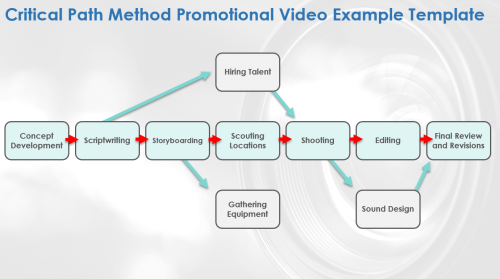
We’ve collected the most useful critical path examples and samples in Excel, Microsoft Word, and PowerPoint formats.
Included in this article, you’ll find the following:
The critical path method (CPM) is a project modeling technique that helps teams identify the sequence of crucial, interdependent tasks in a project. See how CPM helps you prioritize tasks and manage time with this promotional video production project example.

In this downloadable, slide-format example, the critical path is the sequence of tasks highlighted by the red arrows. The tasks on that path (concept development, scriptwriting, storyboarding, location scouting, shooting, editing, and final review and revisions) define the project’s shortest possible duration. The other tasks (hiring talent, gathering equipment, and creating sound design) are important but offer more flexibility in scheduling.
Based on this CPM chart, producers can make more informed decisions so that they can deliver a high-quality video on time:
Critical path analysis involves mapping all project activities with their dependencies and durations. In this example software engineering project, you get more accurate time estimates by breaking larger tasks into smaller components, such as creating a new feature.
 of Attract Group" width="200" height="250" />
of Attract Group" width="200" height="250" />
“In the software development industry, CPM is invaluable for managing complex projects with interdependent tasks,” says Vladimir Terekhov, CEO of Attract Group. “It helps in accurately forecasting project timelines and preventing resource overallocation, which is particularly beneficial in our domain, where time to market can be crucial.”
As an example, imagine a project manager is overseeing the development of a new web-based task management application. They’ll need to break down a complicated project into manageable tasks, accurately estimate completion times, and identify task dependencies that could impact the project flow.
Breaking Down Tasks
Estimating Time Frames

Once you break down the tasks and estimate their durations, the next step is to construct a project timeline using a Gantt chart or project management software.

This visualization allows project managers to allocate resources efficiently, identify potential bottlenecks early, and adjust the project scope or timelines as needed.
There are a number of calculations in CPM that are crucial for determining a project’s minimum completion time and enabling effective planning, scheduling, and resource management. In this example, a team is developing and launching a new online course platform.
In this higher education project, the team starts by breaking down the project into several manageable tasks, estimating the duration of each task, and identifying dependencies:
Task Number
Task Description
Estimated Duration
Dependences